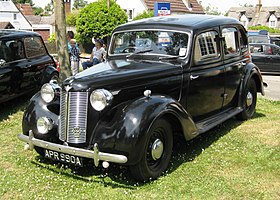
The Hillman Minx was a mid-sized family car that British car maker Hillman produced from 1931 to 1970. There were many versions of the Minx over that period, as well as badge-engineered variants sold by Humber, Singer, and Sunbeam.
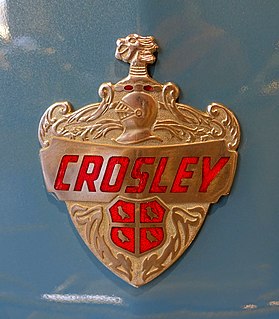
Crosley was a small, independent American manufacturer of subcompact cars, bordering on microcars. At first called the Crosley Corporation and later Crosley Motors Incorporated, the Cincinnati, Ohio, firm was active from 1939 to 1952, interrupted by World War II production. Their station wagons were the most popular model, but also offered were sedans, pickups, convertibles, a sports car, and even a tiny jeep-like vehicle. For export, the cars were badged Crosmobile.
Economy car is a term mostly used in the United States for cars designed for low-cost purchase and operation. Typical economy cars are small, lightweight, and inexpensive to both produce and purchase. Stringent design constraints generally force economy car manufacturers to be inventive. Many innovations in automobile design were originally developed for economy cars, such as the Ford Model T and the Austin Mini.

Ashley were manufacturers of body shells and chassis for specials from 1955 to 1962. They also offered a range of products for special builds: radiators, header tanks, lighting sets, steel tubing, sheet aluminium, various suspension parts, water pumps, tires, tubes and wheels. The company also made bonnets and hardtops for other mass-produced sports cars, including the Austin-Healey Sprite and Jaguar E-Type.

The Morris Minor is a British economy family car that made its debut at the Earls Court Motor Show, London, on 20 September 1948. Designed under the leadership of Alec Issigonis, more than 1.6 million were manufactured between 1948 and 1972 in three series: the MM, the Series II, and the 1000 series.

The Silver Wraith was the first post-war Rolls-Royce. It was made from 1946 to 1958 as only a chassis at Rolls-Royce's former Merlin engine plant, their Crewe factory, alongside the shorter Bentley Mark VI. The Bentley too was available as a chassis for coachbuilders but also for the first time could be bought with a Rolls-Royce built standard steel body.
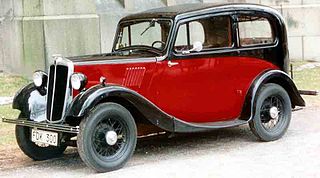
The Morris Eight is a small family car produced by Morris Motors from 1935 to 1948. It was inspired by the sales popularity of the Ford Model Y, styling of which the Eight closely followed. The success of the car enabled Morris to regain its position as Britain's largest motor manufacturer.

The Austin Ten is a small car that was produced by Austin. It was launched on 19 April 1932 and was Austin's best-selling car in the 1930s and continued in production, with upgrades, until 1947. It fitted in between their "baby" Austin Seven which had been introduced in 1922 and their various Austin Twelves which had been updated in January 1931.
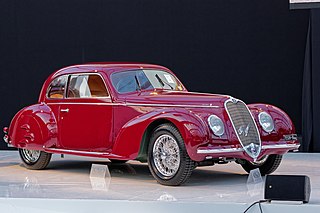
The Alfa Romeo 6C name was used on road, race, and sports cars produced between 1927 and 1954 by Alfa Romeo; the "6C" name refers to the six cylinders of the car's straight-six engine. Bodies for these cars were made by coachbuilders such as James Young, Zagato, Touring Superleggera, Castagna, and Pinin Farina. Beginning in 1933 there was also a 6C version with an Alfa factory body, built in Portello. In the early 1920s Vittorio Jano received a commission to create a lightweight, high performance vehicle to replace the Giuseppe Merosi designed RL and RM models. The car was introduced in April 1925 at the Salone dell' Automobile di Milano as the 6C 1500. It was based on Alfa's P2 Grand Prix car, using a single overhead cam 1,487 cc in-line six-cylinder engine, producing 44 horsepower. In 1928 the 1500 Sport was presented, which was the first Alfa Romeo road car with double overhead camshafts.

The Morris Major and Austin Lancer are passenger car models that were produced by BMC Australia between 1958 and 1964.

The DKW F8 compact front-wheel drive two-stroke engined saloon was introduced in 1939. The F8 was slightly shorter than its predecessor despite having a marginally increased wheelbase. The base model, known as the Reichsklasse, was manufactured only till 1940 but the Meisterklasse sedan continued in production until 1942. In addition to the saloons, cabriolet versions were offered.

The Opel 4 PS, popularly known as the Laubfrosch (treefrog), is a small two-seater car introduced by the auto maker Opel early in 1924. Subsequently, various versions of the little Laubfrosch were produced until it was replaced by the Opel 1.2 litre.

Canadian Military Pattern (CMP) trucks were mutually coherent ranges of military trucks, made in large numbers, in several classes and numerous versions, by Canada's branches of the U.S. 'Big Three' auto-makers during World War II, compliant to British Army specifications, primarily intended for use in the armies of the British Commonwealth allies, but also serving in other units of the British Empire.

The Humber Snipe was a four-door luxury saloon introduced by British-based Humber Limited for 1930 as a successor to the Humber 20/55 hp at the same time as the similar but slightly longer Humber Pullman.
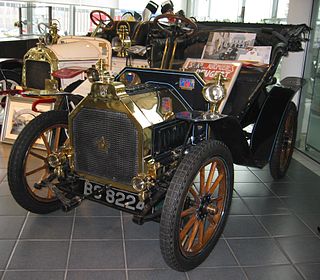
The Peugeot Type 58 is an early motor car produced by the French auto-maker Peugeot at their Audincourt plant in 1904. Despite being in production for only a year, 121 were produced.

The Ford Taunus G93A is a small family car that was produced by Ford Germany between 1939 and 1942 in succession to the Ford Eifel. It was the first car developed at Cologne by Ford Germany which previously had built cars originated by Ford businesses in the US or the UK. Production began on 30 April 1939, with the first car exhibited to the public in June 1939, less than six months before the outbreak of war in Europe.
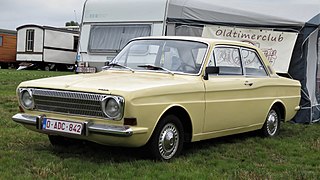
The Ford Taunus 12 M is a range of large family saloons/sedans that were produced by Ford Germany between 1966 and 1970. There were two different engine sizes in the 12M. Two larger engines were available in the otherwise very similar Ford Taunus 15 M. From the outside the 15M was differentiated by its grill and rectangular headlights from the 12M which had round front lights. A complicating feature was the availability, at extra cost, of one of the larger engines from the 15M in the 12M.

The Panhard et Levassor Dynamic is a large car introduced by the French auto-maker Panhard et Levassor as a replacement for the company’s CS model at the Paris Motor Show in October 1936.

Société des Automobiles Bellanger Frères was a French automobile manufacturer between 1912 and 1925. The cars were the brainchild of Robert Bellinger (1884-1966), who had previously sold Delaunay-Belleville vehicles.

In 1939 Dodge presented a completely new designed line of pickups and trucks. Formally the T series for 1939, V series for 1940, and the W series from 1941 through 1947, the trucks became mostly known as the Dodge Job-Rated trucks.
